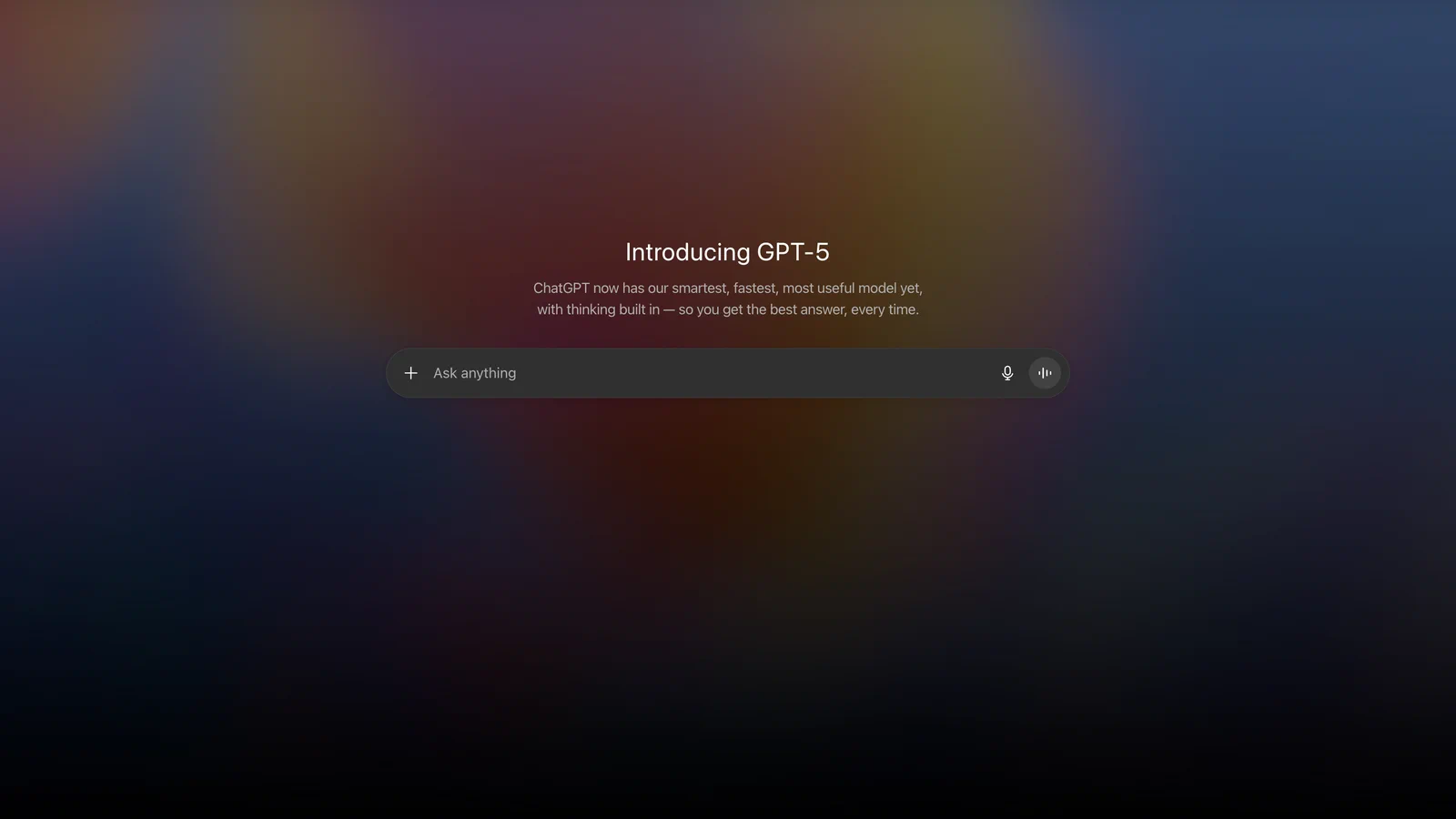GPT-5 is here: What businesses need to know now

GPT-5 is here: What businesses need to know now
GPT-5 launched on August 7, 2025, marking OpenAI’s most significant advancement since GPT-4 with a unified architecture that combines reasoning capabilities with conversational speed. The model achieves 74.9% accuracy on complex coding tasks and reduces factual errors by 76% compared to GPT-4o, positioning it as what Sam Altman calls “a legitimate PhD expert in any area.” For businesses, GPT-5 represents a fundamental shift from using AI tools to working alongside an intelligent system that can handle complex, multi-step problems while maintaining enterprise-grade reliability. Early adopters like Amgen report " increased accuracy and reliability, higher quality outputs and faster speeds," with the model now available through multiple tiers including API access at $ 1.25 per million input tokens. The timing is critical: 42% of US venture capital now flows to AI companies, and enterprises that move quickly to integrate GPT-5’s capabilities will gain significant competitive advantages in productivity, customer service, and innovation capacity.
A unified intelligence system transforms business capabilities
GPT-5 fundamentally reimagines AI architecture by unifying multiple specialized components into a single intelligent system. Unlike previous models that required choosing between speed or reasoning depth, GPT-5 employs a real-time router that automatically determines whether to provide instant responses or engage deeper analytical thinking. The system includes multiple variants, GPT-5, GPT-5-mini, GPT-5-nano, and GPT-5-chat, each optimized for different use cases and price points. This architectural innovation delivers remarkable performance improvements: 94.6% accuracy on advanced mathematics problems without tools, 88% on complex coding tasks, and an 80% reduction in factual errors when reasoning mode is enabled.
The technical specifications reveal substantial advancement over GPT-4. With a 272,000 token input limit and 128,000 token output capacity, GPT-5 can process entire codebases, lengthy documents, or complex datasets in single interactions. The model’s parameter count, estimated between 3 and 50 trillion, represents a 10-20x increase over GPT-4’s architecture. Training required six months on Microsoft’s AI supercomputing clusters using NVIDIA H200 GPUs at an estimated cost exceeding $500 million. The September 30, 2024 knowledge cutoff ensures current information, while the integration of over 50 trillion tokens of synthetic training data enhances specialized capabilities.
For enterprises, these technical improvements translate directly into business value. Notion reports that GPT-5’s “rapid responses make it an ideal model when you need complex tasks solved in one shot,” while Inditex emphasizes the model’s “nuanced, multi-layered answers that reflect real subject-matter understanding.” The unified architecture means businesses no longer need to manage multiple AI models for different tasks, GPT-5 adapts its approach based on problem complexity, optimizing both performance and cost efficiency.
Sam Altman’s sobering Manhattan Project comparison raises stakes
OpenAI’s leadership has expressed both excitement and concern about GPT-5’s capabilities. During a July 2025 podcast appearance, Sam Altman made a striking comparison: “There are moments in the history of science where you have a group of scientists look at their creation and just say: ‘What have we done?’” He explicitly likened GPT-5’s development to the Manhattan Project, adding that “there are no adults in the room” when it comes to AI oversight keeping pace with technological advancement. These statements gain weight considering Altman’s direct experience with GPT-5’s capabilities, which he describes as feeling “very fast” and representing the first time “it really feels like you’re talking to an expert in any topic.”
The sobering tone contrasts sharply with OpenAI’s confident marketing messaging. Altman admitted feeling “nervous and scared over what he’d helped build,” even while promoting GPT-5 as bringing “expert-level intelligence to everyone’s hands.” His prediction that AI systems will soon “compress ten years of scientific progress into just one year” and that by 2035 any individual could access “intellectual capacity equivalent to everyone alive in 2025” suggests transformative, and potentially disruptive, changes ahead. Multiple OpenAI executives departed in 2024, including CTO Mira Murati and co-founder Ilya Sutskever, though the company maintains these changes reflect normal evolution rather than safety concerns.
OpenAI has implemented extensive safety measures in response to these concerns. The company conducted 5,000 hours of red-teaming with partners including the UK’s AI Safety Institute, developed a new “safe completions” framework that provides helpful responses while avoiding harmful content, and achieved significant improvements in reliability metrics. GPT-5 shows only a 2.1% deception rate compared to 4.8% for previous models, addressing a key concern about AI trustworthiness in business applications.
Competition intensifies as rivals match specific capabilities
The AI landscape has fragmented into specialized domains where different models excel. Google’s Gemini 2.5 Pro currently dominates math, science, and coding leaderboards with a 1 million token context window expanding to 2 million, plus native multimodal capabilities handling text, images, audio, and video seamlessly. Its real-time Google Search integration and January 2025 knowledge cutoff provide advantages for current information retrieval. Anthropic’s Claude 3.7 Sonnet demonstrates superior coding capabilities and offers a 200,000 character context window with transparent reasoning processes, though at higher cost, $0.90 per full reasoning interaction versus $0.04 for GPT-4.5.
Meta has disrupted the market with Llama 4 Behemoth, featuring 288 billion active parameters and outperforming GPT-4.5, Claude Sonnet 3.7, and Gemini 2.0 Pro on STEM benchmarks. Llama 4 Scout’s industry-leading 10 million token context length dwarfs competitors, while its open-source nature eliminates API costs for companies willing to self-host. However, license restrictions prevent EU usage and require special licenses for companies with over 700 million users, limiting enterprise adoption.
GPT-5’s competitive advantages center on its unified architecture, Microsoft enterprise integration, and cost efficiency. The model offers 2-20 times lower costs than Gemini’s extended reasoning capacity while maintaining comparable performance. Full integration with Azure AI Foundry provides enterprise-grade security, compliance certifications, and seamless connection to Microsoft 365, Teams, and SharePoint. Early enterprise feedback confirms GPT-5’s practical advantages: improved context retention, better ambiguity navigation, and faster response times that translate into measurable productivity gains.
Enterprise adoption accelerates with clear ROI metrics
Major consulting firms are experiencing fundamental transformation through AI integration. McKinsey reports that 40% of projects now involve AI, with their internal platform “Lilli” handling over 500,000 monthly inquiries. BCG achieves 30-40% efficiency gains for junior analysts and 20-30% for experienced staff, while Bain has equipped all 18,000 consultants with AI tools. These firms are shifting from time-based billing to value-based pricing models and restructuring from traditional pyramid hierarchies to flatter, specialized teams.
The financial implications are substantial. AI startups received 53% of all global venture capital dollars in H1 2025, with 42% of US venture capital flowing to AI companies in 2024. Twenty AI companies have raised over $2 billion each, signaling massive market confidence. McKinsey’s research identifies a $ 4.4 trillion productivity growth potential from AI, though only 1% of companies consider themselves “AI mature” despite 92% planning to increase investments over the next three years.
Practical business applications span every major function. In customer service, GPT-5 handles complex inquiries with 80% fewer factual errors while providing personalized responses. Software development teams report state-of-the-art performance with the model excelling at bug fixes and complex codebase management. Healthcare applications show remarkable precision with only 1.6% hallucination rate on medical questions, while financial services leverage enhanced reasoning for risk assessment and fraud detection. Supply chain managers use GPT-5 for real-time optimization and predictive analytics, achieving efficiency gains previously impossible with traditional systems.
Navigating complex regulatory landscape requires proactive compliance
The EU AI Act classifies GPT-5 as a “General Purpose AI model with systemic risk,” triggering comprehensive compliance requirements. Organizations must complete thorough model evaluations, adversarial testing, and serious incident reporting by August 2, 2026 for full compliance. Technical documentation, transparency requirements, and clear labeling of AI-generated content are mandatory. The Act requires fundamental rights impact assessments for certain uses and testing environments that simulate real-world conditions, potentially restricting deployment without proper compliance measures.
US regulatory frameworks remain fragmented but increasingly active. The FTC has received complaints alleging GPT-4 violations of unfair and deceptive practices regulations, while the Biden administration studies accountability measures through the National Telecommunications and Information Administration. * OpenAI’s partnership with the US General Services Administration provides ChatGPT Enterprise to federal agencies at just $1 annually*, signaling government embrace alongside oversight concerns. State-level initiatives are emerging, with Massachusetts legislators using ChatGPT to draft AI regulation bills, highlighting the recursive nature of AI governance.
Safety concerns from the research community remain significant. Google DeepMind researchers warn of “extreme risks” from next-generation models including offensive cyber operations, human manipulation, and harmful instruction capabilities. The Machine Intelligence Research Institute emphasizes that only 3% of technical AI research focuses on safety, while the Center for AI Safety’s 2023 statement declared that “mitigating the risk of extinction from AI should be a global priority.” OpenAI’s response includes a revolutionary “safe completions” framework that shifts from refusal-based to output-centric safety training, addressing dual-use problems where information has both benign and malicious potential.
Strategic implementation roadmap for business leaders
Successful GPT-5 integration requires thoughtful strategy beyond simple adoption. Organizations should begin with comprehensive AI readiness assessments, identifying high-impact, low-risk use cases for initial pilots. * API pricing at $1.25 per million input tokens and $10 per million output tokens enables cost-effective experimentation*, with mini and nano variants offering even lower entry points. ChatGPT Enterprise provides additional features including enterprise-grade security with AES-256 encryption, SAML SSO, SCIM provisioning, and SOC 2 Type 2 certification.
Integration possibilities extend across existing business systems through Azure AI Foundry, with native connectors for Google Workspace, Microsoft 365, GitHub, Notion, Slack, and Salesforce. Custom tool development uses simplified plaintext definitions, while the Model Context Protocol enables enhanced agent capabilities with web automation. Organizations report 70% cost savings through strategic API integration and significant reductions in manual labor costs through automated research and analysis.
The implementation timeline should prioritize quick wins while building toward transformation. Start with customer service automation and content creation, where GPT-5’s reduced hallucination rates provide immediate value. Progress to complex analytical tasks and software development assistance as teams gain comfort with AI collaboration. Establish robust governance frameworks early, including usage policies, quality assurance processes, and continuous monitoring systems. Invest heavily in employee training, formal AI education across all levels proves critical for capturing full value. Organizations that move decisively while maintaining appropriate safeguards will establish lasting competitive advantages in the AI-transformed business landscape.
About the Author

Aaliyah Thompson
Financial Technology Analyst
Fintech writer and former investment analyst with deep understanding of digital finance and market dynamics. Aaliyah brings a unique perspective on the intersection of technology and finance.
